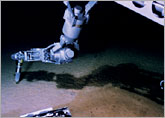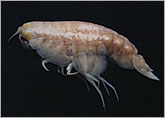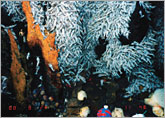Remotely Operated Vehicle
KAIKO
Overview
KAIKO is a world-class remotely operated vehicle (ROV) that excels in maneuverability and specializes in heavy work. The latest version of this ROV (4th generation, Mk-IV) has been repeatedly upgraded, and is mainly intended for deep sea surveys and marine resource surveys that require heavy work. The first ROV KAIKO collected such benthic organisms as Hirondellea gigas at a depth of 10,911 m in the Mariana Trench, and also discovered hydrothermal vent organisms in the Indian Ocean.
Principal specifications
Vehicle (KAIKO Mk-IV)
Activity records
- Apr 2022Vehicle began independent operation (launcher-less).
- Apr 2016The new KAIKO system started operation as one of facilities available for research exploration carried out for projects selected from among the proposals submitted from applicants in and out of JAMSTEC.
- Nov 2013KAIKO’s new Vehicle was constructed and named “KAIKO Mk-IV”.
- Apr 2013Press ReleaseプレスリリースRetrieved temperature sensing loggers which had been installed in the focal area of the 2011 Tohoku earthquake.
- Apr 2006KAIKO’s new Vehicle “KAIKO 7000II” was constructed and launched.
- May 2004Restarted research operation after the ROV “UROV 7K” was converted into KAIKO’s Vehicle “KAIKO 7000”.
- May 2003KAIKO’s Vehicle was lost due to accidental breaking of the secondary cable during research off Shikoku.
- Aug 2000Discovered hydrothermal vents and communities at a depth of 2,450 meters in Indian Central Ridge.
- Nov 1999Discovered the engine wreckage of a Japanese rocket H-2 No. 8 on the sea floor at a depth of 2,900 meters off Ogasawara Islands during the search operation in which JAMSTEC took part after the rocket launching failure.
- Oct 1999Succeeded in connecting the measuring equipment with underwater cables on the sea floor at a depth of 2,150 meters in the Ryukyu Trench area.
- May 1998Collected specimens of the benthic amphipod, Hirondellea gigas (body length: about 4.5 centimeters), at Challenger Deep of Mariana Trench for the first time in the world.
- Dec 1997Identify a shipwreck as the passenger ship TSUSHIMA MARU which was sunk with schoolchildren onboard during the World War II off Okinawa, when participating in the search operation along with JAMSTEC’s deep sea research vessel KAIREI and ROV DOLPHIN-3K.
- Feb 1996Succeeded in collecting sediment samples together with microorganisms at a depth of greater than 10,000 meters (10,898 meters) at Challenger Deep of Mariana Trench for the first time in the world.
- Mar 1995Succeeded in diving to a depth of 10,911.4 meters at Mariana Trench during a sea trial with the support of the support vessel YOKOSUKA, and taking videos of various marine organisms including polychaetes and crustaceans living at great depths.

Sediment samples collected together with microorganisms

Benthic amphipod, Hirondellea gigas

Hydrothermal communities in the Indian Ocean